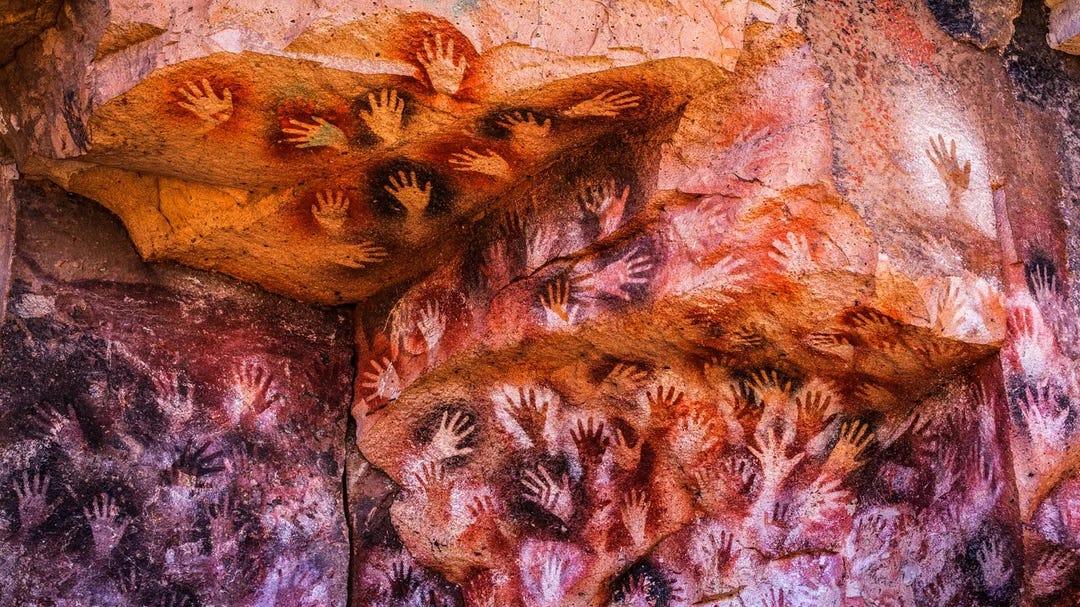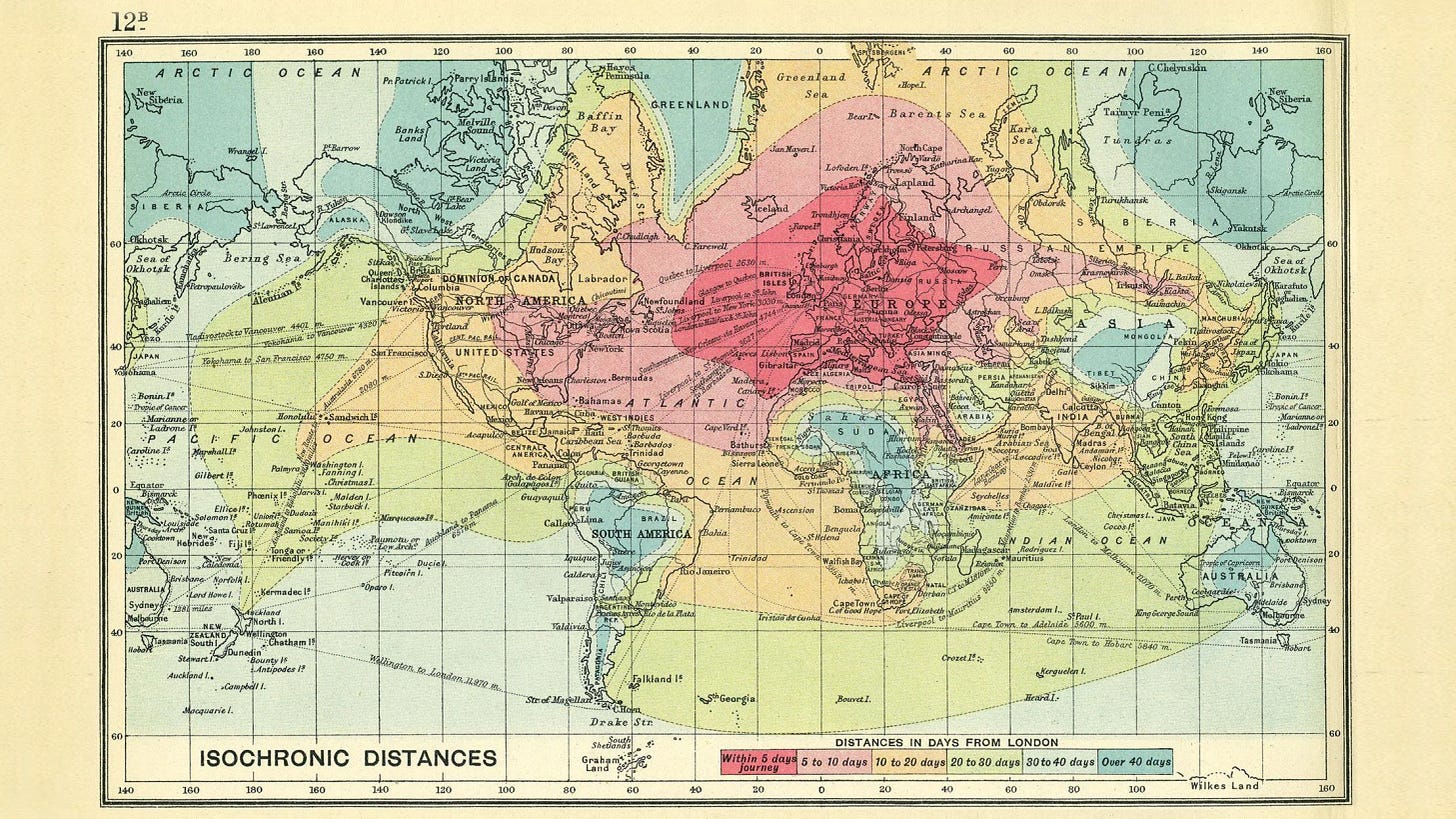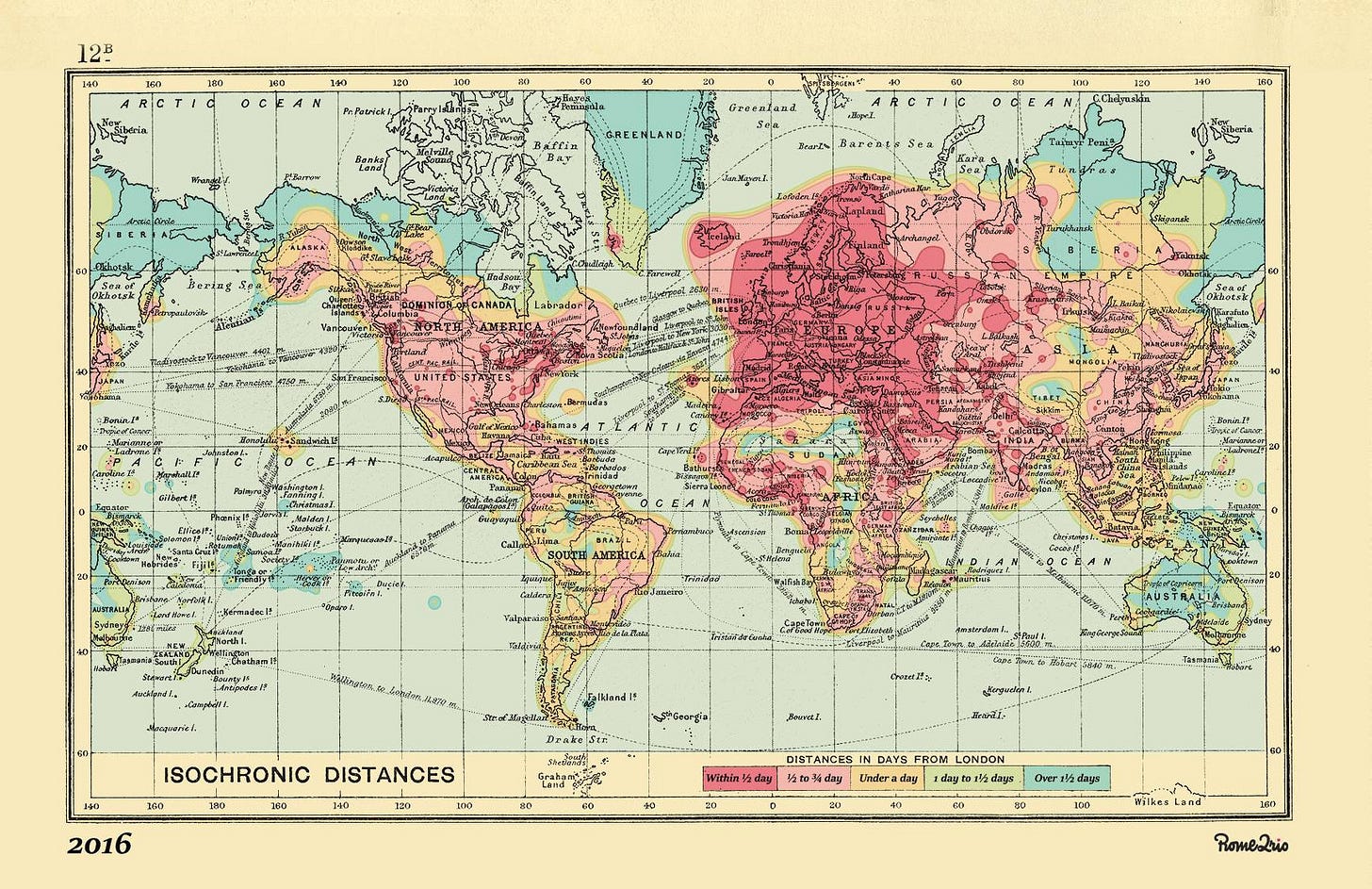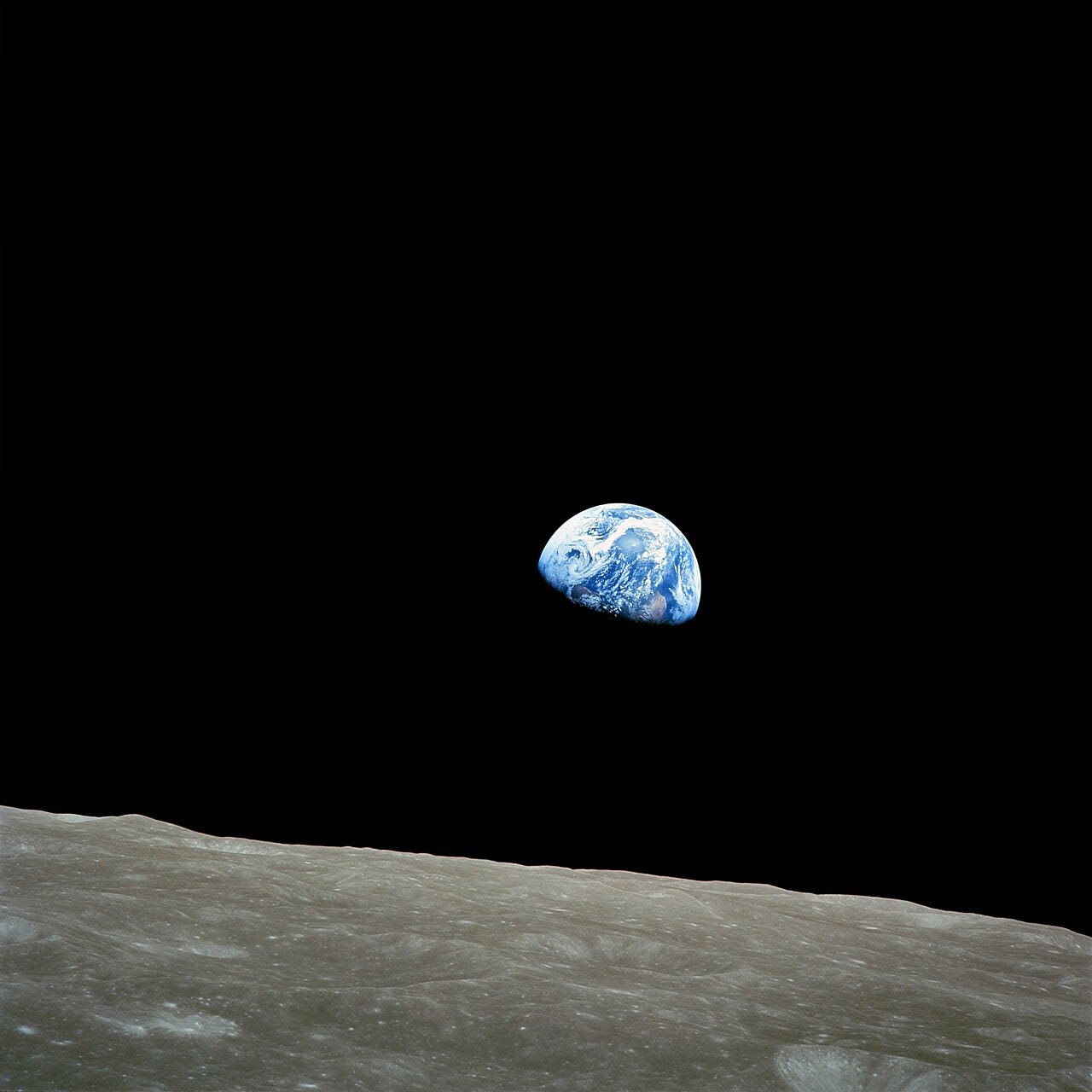We are different from all other humans in history
Countless experiences that have become routine for us are unprecedented in the history of our species. Here's why that matters.
Thank you for reading The Garden of Forking Paths. If you value my work and want to support it, please consider upgrading to a paid subscription for $50/year, which is just $4.16 per month. Your support makes my research possible so I can keep writing for you and keeps me fully independent.
I: Lagged Existence
I recently visited my family in the US and managed to defeat transatlantic jet lag in one night—a small miracle. But as I patted myself on the back for my unusual sleeping prowess, I pondered this jarring reality: in the history of humanity, just three and a half generations of human beings have been able to experience jet lag.
The phenomenon was first identified in 1931. Before then, it wasn’t possible for a human to travel far enough and fast enough to knock their internal circadian rhythms out of sync. Our technological prowess created a novel biological experience that was impossible for roughly 9,497 out of the 9,500 or so generations of Homo sapiens.1
We, the modern humans who are alive today, are unique.
Modern humanity has produced astonishing shifts in historic blinks. Below, for example, is one of the most fascinating maps ever produced—known as an isochronic map—which shows how far from London a human being could plausibly travel in a given time period in 1914, just over a century ago.
The red shaded areas show a journey of five days or less; the pink five to ten days; the yellow ten to twenty days; the green thirty to forty days; all the way up to the darker teal shades which showcase the most remote regions—reachable only after a trek of at least forty days, nearly a month and a half.
Here’s an updated version of that map, from 2016, using data of travel time estimates from the website Rome2Rio. Suddenly, the range goes from days to hours, shades from zero to twelve hours (dark red) to the most isolated places on Earth in teal (more than 36 hours). The furthest reaches of inaccessible terrain on our planet are now far easier to reach from London than were most places in Western Europe a century ago.
It’s mind boggling.
It’s obvious that we experience that which was previously impossible. Nobody who lived before this recent moment could play with artificial intelligence, or instantly communicate with people thousands of miles away while flying over the ocean in a metal tube.
But when you drift away from the obvious technologies, it’s profoundly strange to consider just how much of our lived experience differs from those of virtually every human being who came before us.
II: The Big Picture
Depending on which scientist you ask, Homo sapiens emerged between 200,000 and 315,000 years ago.2 Let’s split the difference, go with 257,000, and say that there have been about 9,500 generations of humans (the average generation throughout human history lasts 26.9 years).
Our way of life was dominated by hunting and gathering for 9,100 of those 9,500 generations—96 percent of the existence of our species.
Then, about 10,000 years ago, agrarian societies first formed. Farming replaced hunting and gathering. (It was disastrous for our health). Fast forward to the 18th century and society shifted again, this time toward industrialization. Now, in the last thirty years or so, we’ve ushered in a radical, rapid shift, with computerization, the internet, and artificial intelligence, a society defined by interconnected information and an unprecedented flow of ideas.
If the history of humanity were condensed into a single 24-hour day, this is roughly what it would look like:
The Hunter-Gatherer Age—23 hours and 3 minutes
The Agrarian Age—55 minutes and 32 seconds
The Industrial Age—1 minute and 17 seconds
The Information Age—11 seconds
More than half of the world’s population is under the age of 30, meaning that the majority of humans alive today have only lived in those 11 seconds—an era that is, without question, the weirdest period in human history.
Consider, for example, this observation, conveyed by the Dutch sociologist Ruut Veenhoven: “the average citizen lives more comfortably now than kings did a few centuries ago.”
A Snickers and a power shower would blow Henry VIII’s mind.
This morning, I woke up in a supremely comfortable bed, knowing there would be no deadly predators or pests to eat or infect me. With cheap soaps and pristine, hot water, I became cleaner in five minutes than was possible for any human—no matter how wealthy—in the past.
With a flick of a switch, I conjured hot coffee into existence with a taste and quality that could not have been summoned by any empire or fleet previously. In a safe car that could rapidly whisk me to another country in a few hours—by driving onto a train that literally travels under the ocean—I typed a few keystrokes on a magic device that allowed me to listen to virtually any music recorded, anywhere on the planet, in the last century or so. And the entire time, I never feared violence, starvation, disease, or death.
When we compare ourselves to humans past, we, not them, are the weird ones. And the more you peer at modern social reality, the more extraordinary our differences seem.
III: The Whole Planet View
“It was the most beautiful, heart-catching sight of my life,” said Frank Borman, commander of the Apollo 8 mission, as he looked back at the entirety of Earth from space. The first clear, color photograph of our planet was taken on December 24, 1968, during that mission.
The photograph, known as Earthrise, was the first time that humanity could see our comparative insignificance in the universe, understand viscerally the petty pointlessness of humans hurting and killing one another, and know the fragility of existence.
Edgar D. Mitchell, an astronaut on Apollo 14 and the sixth man to walk on the moon, memorably put it like this:
“You develop an instant global consciousness, a people orientation, an intense dissatisfaction with the state of the world, and a compulsion to do something about it. From out there on the moon, international politics look so petty. You want to grab a politician by the scruff of the neck and drag him a quarter of a million miles out and say, ‘Look at that, you son of a bitch.’”
As with jet lag, 9,497 of the 9,500 prior generations of humans never saw our planet, never developed that global consciousness. We, the lucky ones, have—even if we sometimes could use a reminder of it, by gazing at the arresting Pale Blue Dot image. It was a photograph taken from 3.7 billion miles away, where it’s hard to make out the little pixel that contains all of us and everything humanity has ever done.
IV: Local vs. Global Instability
In the prehistoric past, life didn’t change that much from one generation to the next. However, daily life was far more unpredictable.
As I wrote in Fluke:
The past was largely defined by local instability. Day-to-day life was unpredictable. One day you could be healthy, the next day you could be dead, struck down by a mysterious plague. Childbirth was a death trap. Starvation was a constant threat, as crops might inexplicably fail, or animals that were once abundant were suddenly nowhere to be found.
But our distant ancestors also experienced global stability. That didn’t mean that the world never changed, but rather that, broadly speaking, society ticked along more or less in similar ways from one generation to the next. If your parents were agrarian peasants, you were likely to be an agrarian peasant.
We, modern humans, have inverted that dynamic. Our daily lives are highly regimented, regulated, and stable. Routine defines us. Researchers studying mobility patterns using geolocations from mobile phone data found that they could predict, with 93 percent accuracy, where someone would be at any given time of day based on their past patterns of movement. We click a button and a package shows up in a pre-determined window at our doorstep. Google Maps tells us, within minutes, how long it’ll take to traverse hundreds of miles. We experience local stability.
It gives us a profound illusion of control, forged through lived experience.
But it is an illusion. The macro-framework of our lives is constantly changing. I’m part of a generation that started without the internet, home computing, mobile phones, or artificial intelligence, but now spends much—if not most—of our waking life interacting in some way with those technologies. There are constant shocks—pandemics, wars, climate upheaval. The experience of life changes drastically from one generation to the next. Unlike the overwhelming majority of our ancestors, we experience global instability.
We’ve invented an upside-down world where Starbucks never changes, while rivers dry up and democracies collapse.
This has also created a dynamic that would be utterly bizarre to every other human from the past: children teach their parents how to use technology rather than the reverse. It’s a complete inversion of the transmission of knowledge through generations, which, until now, was always a one-way arrow from older to younger.
V: From “Few to Many” to “Many to Many” Communication
The rise of the internet has also shifted the flow of information in ways that are unique to modern humans—with often catastrophic effects on our social systems.
Until the Information Age, the history of human information flows has been a gradual expansion of the number of people who could consume information.
In the prehistoric past, virtually all communication was local, so only tiny groups of people could transfer information among themselves. As agrarian society made empires possible, a small, select group of humans—the rich and powerful—could disseminate information more widely. But it was slow, and ordinary people rarely received the message. (Recall the scene in Monty Python and the Holy Grail in which the peasant had never heard of King Arthur, nor of the Britons that he allegedly ruled.)
The rise of the printing press, the telegraph, newspapers, radio, and television each drastically expanded the accessibility of information to the masses. Suddenly, most humans on the planet could receive information produced by faraway people. But they couldn’t produce and disseminate information themselves. They were passive readers, listeners, or viewers—not creators. And there were always elite gatekeepers who shaped, framed, and determined the spread of information.
The internet has forever changed the spread of human information, shifting us from few to many communication to many to many communication. The social ramifications of this shift are the primary cause of many political calamities of our age, as conspiracism, polarization, disinformation, and the breakdown of a shared sense of reality plague modern society in ways that are unlike anything ever experienced by our species.
VI: Globalized Social Comparison
The instant, global spread of information has also yielded a disorienting social result: the rise of nonlocal social comparisons. Every human throughout history inhabited a social world that was localized, where their sense of self-worth, their place on the social hierarchy, their internalized cultural norms, and their beauty standards were judged against a reference point that was in their immediate geographical vicinity.
Localized social comparison did erode a bit from the rise of mass visual media, such as television, but the shift to globalized social comparison was put on steroids (sometimes quite literally) by social media. For 96 percent of the span of Homo sapiens, the reference category we used as a comparison was only—at most—a few hundred people.
Now, it’s quite literally billions.
VII: Cultural Standardization vs. Lifestyle Divergence
A decade and a half ago, I went to a little bar in Togo, in West Africa. It was called a bar, at least, but it was really just a shack on the side of a dirt road with a corrugated metal roof, some plastic lawn chairs, and a small, noisy refrigerator. As I sat down, I was offered a can of Coke and a dusty bottle of Heineken as the familiar sounds of The Pussycat Dolls filled the air.
The now-routine experience of instant cultural familiarity after traveling thousands of miles from home would have been both bewildering and impossible prior to the last few decades. While cultural diversity persists—thank goodness—the band has narrowed, likely irrevocably.
However, even though cultural convergence is a real phenomenon, the span of possible lifestyles between human groups are more different than ever before.
There was far more lifestyle convergence in the prehistoric past, when pretty much everyone lived their lives as a hunter-gatherer. Nobody was living a jet setting life of luxury while others languished in starving poverty.
By contrast, today’s enormous global inequality means that the patterns of daily life—from, say, the skyscrapers of Hong Kong to the huts of hunter-gatherers in Papua New Guinea—that are more different across space than ever before in the history of our species.
VIII: Disconnecting from Nature
Humans evolved to live in and connect with nature. This is obvious if you consider that, until very recently, our survival was innately tied to understanding the natural world. Not so today, where “nature” is conceptualized as somewhere else, a place we feel we must seek out, rather than a world we already live within.
Technology has made us spend more of our lives indoors, plopped in front of screens, rather than basking in the elements and exploring wild terrain.
One study, for example, simply charted how often English-language fiction used words related to the natural world, from 1900 to 2000. The authors explain that our linguistic distancing from nature is due to “technological change, and in particular the burgeoning of indoor and virtual recreation options.” Sure enough, an abrupt decline begins around the era of mass television, proceeding further downward as home computing and the internet become ubiquitous from the 1990s onward.
This unfortunate turn from nature has profoundly affected how we see ourselves—as we imagine humanity as above and aloof from, rather than part of, our natural world. (That delusion will not survive climate change, I suspect.) But it’s obvious that our conception of humanity’s relationship with nature—one of distance and dominance—would be beyond alien to almost every other human who came before us.
IX: Bioengineering and Gene Editing
Finally, prior to us, humans could not change the hidden chemical recipes within ourselves by any means other than altering diet (and even then, options were limited). Of course, our ancestors weren’t even aware that those chemical recipes existed. Today, by contrast, we have begun to unlock the secrets of the human genome so much that we have begun editing ourselves.
In November 2023, the UK health regulator approved the use of a wizard-like technology, CRISPR, to treat sickle-cell patients. As Jocelyn Kaiser explains:
After harvesting a patient’s blood stem cells, scientists use CRISPR to disable the genetic switch that normally turns off this fetal hemoglobin gene early in development. The cells are then reinfused into the body, where newly made hemoglobins take up the job of transporting oxygen.
Then, in May of this year, the first patient was successfully treated with CRISPR for a rare genetic defect. This will be life-changing for those who receive the genetic modifications. But what an utterly extraordinary time to be alive, witnessing a moment in which it becomes increasingly routine for us to hit the delete key on harmful genes that lurk within us.
X: A Grab Bag of Differences
There are countless other differences I could have highlighted, such as:
The first abrupt decline of extreme poverty, which I wrote about here.
The ability to explain the surface of the Earth around us (plate tectonics only became widely accepted in the late 1960s)
Access to all kinds of food regardless of seasonality.
Life expectancy (which drastically increased since 1950).
Obesity being correlated with poverty rather than wealth.
The plummeting rate of death due to infectious disease.
Until very recently, the average parent buried at least one of their children—and a much larger proportion of women died in the process of giving birth to one.
We live in an extraordinary world, of profound, disorienting change, immense comfort, unprecedented prosperity, depressing political peril, and existential risk. It’s an experience of living that’s jarring, thrilling, and worrying. But it’s worth zooming out and celebrating that many of our most banal daily experiences are unique, impossible for all humans who came before us.
What did I miss? Comment below, trying to restrict your ideas to that which is unique to the three most recent generations of humans (from WWII to the present, more or less)—and was literally impossible before that. If you’d like to support my writing—and get full access to 210+ essays—please consider upgrading to a paid subscription. Alternatively, consider buying a copy of my book, FLUKE: Chance, Chaos, and Why Everything We Do Matters.
This rough calculation comes from the fact that the average length of a human generation throughout the history of our species is 26.9 years (and assumes that Homo sapiens have been around for roughly 255,000 years).
Recent research and the discovery of a new skull (from two weeks ago) suggests that our species may have begun to emerge 500,000 years earlier than previously thought, which is quite a big range of uncertainty.








What I love about this is how you simultaneously hold an appreciation for the marvels of our modern existence and a clear-eyed observation of the existential risk embodied within it. Thank you for not condemning modernity. At the same time, and more important in my view, thank you for seeing it clearly and articulating the challenges we face. This is a gift.
Awesome post!
Another difference I want to add (that's tied to trends you've already addressed): In the past few generations, music went from being something that nearly everyone participated making in to something that only a tiny minority of people participate in making, but that it's much easier than it was in the past to passively consume.
You note the bar in Togo playing the Pussycat Dolls--an example of this passive consumption of homogenized global pop culture. But if we go back to 1900, basically everyone in Togo--and London, and West Virginia, and everywhere else--makes music with other people on a very regular basis. There's no real way of sharing recorded versions of this music yet, which keeps Togo's music very distinct from West Virginia's; but also since it's passed down mainly orally and through practice, songs do evolve over time.
I think it's easy for us moderns to forget what a universal experience music-making was in the past, because we're so used to it being something for experts like, say, the Pussycat Dolls, and we assume other people were like we are now, except that maybe just the wealthiest people got to see performances. But actually, just normal people were singing all the time at work and at worship, and figuring out how to make new musical instruments with whatever was available. This is a once-universal avenue of creativity we've largely cut ourselves off from.
Music-making is also a previously near-universal means of community-building. Playing/singing music with other people has psychological effects that tie people together in a way I never understood until I took up an instrument and started playing with others as an adult. Speaking for myself, a former appreciator of music I passively consumed and current producer of (not nearly as polished!) music with my friends, I think that moderns who merely listen to music are profoundly ignorant of what we gave up when we stopped making music together.